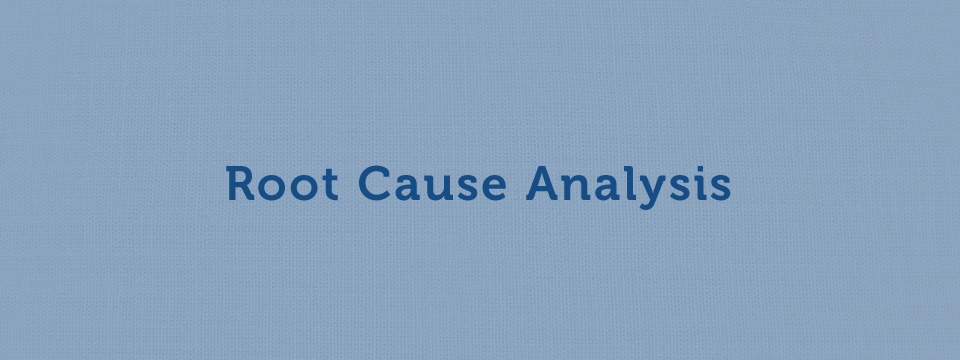ThinkReliability often investigates big explosions or multi-million dollar supply chain break downs. Cause Mapping is a process that reveals simple solutions to complex problems so we are usually called in to help companies with large scale incidents. But I have found that the process of Cause Mapping can be a useful tool in solving very simple, minor
 problems and truths about the process of Cause Mapping can be revealed by practicing it in miniature.
problems and truths about the process of Cause Mapping can be revealed by practicing it in miniature.
I take many flights every year and so, getting to the plane on time is a fundamental requirement for getting my job done. If I miss a flight, its important that I find out “why” and enact some sort of preventative measure to ensure that I don’t repeat that error. So, when I missed a recent flight out of Chicago, it provided a perfect opportunity to do a self-investigation and a miniature Cause Map.
Here is the “Story”.
As I was leaving a client office I realized that there was time to get some Chicago Deep Dish Pizzas and take them home. My family really loves it when I can bring something special back from a trip. I found a restaurant not far from the airport. I was able to arrange preparation of the pizzas for transport. Getting to the restaurant was more tricky than I had anticipated but I found a good parking spot so all was going smoothly. I was actually rather proud of myself as I found I had arrived at the airport with time to spare. As I approached the terminal I was confused by some of the signs and I turned into the airport departure and arrival area rather than rental car return area. Back-tracking required an extra 10 minutes to get to the rental car area. Now, I would have to move quickly, but I would still make my flight.
I arrived at the rental car return area approximately 60 minutes prior to the scheduled flight departure. An item needed to be checked onto the aircraft and the requirement is 45 minute baggage check minimum. Haste was needed to get from the rental car area (walking distance – no bus ride required) to the ticket counter. Now, I was feeling rushed and, in my haste, I made an error. I left my cell phone in the rental car. Normally the cell phone would stay in my pocket or briefcase. However the cell phone was left on the center console in the rental car. The console was black and the phone was black; I had scanned the area but hadn’t noticed it. By the time I realized my error and worked with the rental car company to retrieve the car and the phone, only fifteen minutes remained before the scheduled flight departure and I still needed to get through security.
 Needless to say as I walked up to the gate the door had just closed. The airline officials were more than accommodating and no additional airline costs were required; however, an overnight hotel stay was required.
Needless to say as I walked up to the gate the door had just closed. The airline officials were more than accommodating and no additional airline costs were required; however, an overnight hotel stay was required.
 After a failure of any kind, it is human nature to look for someone to blame. My mind went through a list of “if only’s”: if only the restaurant had been in a better location, if only the rental car company hadn’t taken fifteen minutes to retrieve my car, if only the signs in the airport had been more clear etc., etc. ad nauseum.
After a failure of any kind, it is human nature to look for someone to blame. My mind went through a list of “if only’s”: if only the restaurant had been in a better location, if only the rental car company hadn’t taken fifteen minutes to retrieve my car, if only the signs in the airport had been more clear etc., etc. ad nauseum.
But, when I got home I worked up a simple Cause Map that allowed me to escape my own private culture of blame and find a rather interesting action item to prevent this sort of failure in the future.
By following the same procedure that I would for a multi-million dollar issue, I was able to identify a simple solution that would prevent this particular incident from recurring. I could not move the pizza place, I could not re-write the airport signs. There were many things in the scenario that were clearly out of my control. I could be more diligent about putting my cell phone back in my briefcase but that solution depended solely on “operator behavior” which is not completely reliable. So, I, the management, decided to purchase a very distinctive case and lanyard for my cell phone. This bright orange rubber case is a bit of an eye-sore according to my wife but, it certainly draws attention to itself. It stands out against the dark console of a rental car and has helped me keep track of my cell phone on a daily basis.

 We often see “Procedure not followed” as a finding in a Root Cause Analysis Investigation. It is not uncommon that the investigation will stop at that point and the corrective action becomes; “Follow the Procedure”. Taking the process to the next step is crucial. Why was the procedure not followed? How can we make it more likely that the procedure will be followed in the future? Sometimes a very small adjustment can be the key to prevention.
We often see “Procedure not followed” as a finding in a Root Cause Analysis Investigation. It is not uncommon that the investigation will stop at that point and the corrective action becomes; “Follow the Procedure”. Taking the process to the next step is crucial. Why was the procedure not followed? How can we make it more likely that the procedure will be followed in the future? Sometimes a very small adjustment can be the key to prevention.
 Companies often reach very general causes in their investigations. For example, the identified cause may be “Not paying attention”.
Companies often reach very general causes in their investigations. For example, the identified cause may be “Not paying attention”.
Just like the proverb, the devil is in the details, and the solutions are there too. Root cause analysis is an investigation approach for digging into what’s beneath the surface.
We provide free Excel templates and reference information on our website. If you are interested in learning more please go to our website at http://www.thinkreliability.com. View the Cause Map I’ve worked up for this issue by clicking on “Download PDF” above.
Cheers,
Loyd

